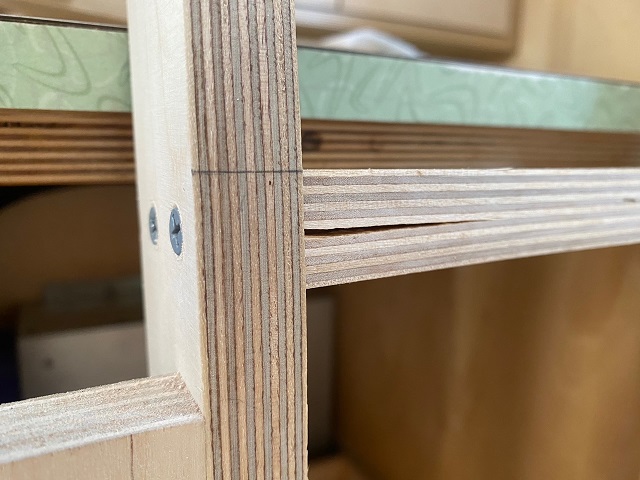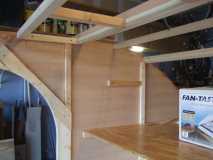Page 1 of 1
Anybody use layered ply for roof spars?

Posted:
Thu Mar 11, 2021 11:06 amby Bretster
Hi All,
I am in the design and material/tools gathering phase of my TD build. I have a trailer and hope to start building soon. It will be a little less than 60" wide and will be 120" long. Using insulated skeleton, floor and roof as I live in Canada and would use TD in cold temps. I am using Tony Latham's guide as a general outline but have a lot of modifications I would like to incorporate.
First idea is to use 2 layers of 3/4" ply glued together for roof spars, interior floor spars and for the hatch. I would likely use a little wider than suggested spacing on the roof, and would match trailer frame x-brace locations, with an additional spar in the galley area. Anybody use this approach? If so, how did it work? Any good reasons not to use ply?
Thanks for any help that is provided!
Re: Anybody use layered ply for roof spars?

Posted:
Thu Mar 11, 2021 11:27 amby tony.latham
Any good reasons not to use ply?
I think it's a good idea. As you may have noticed, I used that approach with my floor system.
My only concern would be splitting from mechanical fasteners, but I didn't experience any with my floor cross members and they were only 3/4" high.
Tony
Re: Anybody use layered ply for roof spars?

Posted:
Thu Mar 11, 2021 6:31 pmby eLink
tony.latham wrote:My only concern would be splitting from mechanical fasteners
Tony
Yup. Even with pre-drilled pilot holes!

Re: Anybody use layered ply for roof spars?

Posted:
Thu Mar 11, 2021 9:01 pmby saltydawg
eLink wrote:tony.latham wrote:My only concern would be splitting from mechanical fasteners
Tony
Yup. Even with pre-drilled pilot holes!

You probably would have been fine if you did pocket screws from the other side. Did you pre drill?
Re: Anybody use layered ply for roof spars?

Posted:
Fri Mar 12, 2021 8:32 amby OP827
Plywood spars will be slightly heavier, weaker and less rigid than solid hardwood. The plywood advantage is dimensional stability along the grain, which not going to help in spars application. I would not do it. Glue laminated spar similar to birch laminated Ikea chairs would work better, but not required or not optimal in this application. The above is my own opinion.
Re: Anybody use layered ply for roof spars?

Posted:
Fri Mar 12, 2021 9:57 amby swoody126
a number of boat designers are using laminated arched beams for their roof structures where only epoxy is intended for the attachment of the 2 components
otherwise the use of cleats is required
most often this procedure is only designed in when there would otherwise be wasted plywood and proper joinery is not an expected skill of the intended builders
even then thickened epoxy fillets on both sides of the joint are required to insure stabiity/integrity for structural framing
sw
Re: Anybody use layered ply for roof spars?

Posted:
Fri Mar 12, 2021 10:31 amby Graniterich
saltydawg wrote:eLink wrote:tony.latham wrote:My only concern would be splitting from mechanical fasteners
Tony
Yup. Even with pre-drilled pilot holes!

You probably would have been fine if you did pocket screws from the other side. Did you pre drill?
Pocket screws all the way!
Re: Anybody use layered ply for roof spars?

Posted:
Fri Mar 12, 2021 10:53 amby OP827
On another thought, if you are gluing plywood skins to your spars inside and out side the spar material is less relevant to overall rigidity and structure streght since the skins will be stressed first, than the spars inside. Some teardrop builds were done successfully with foam only and plywood skins glued as a sandwich.
Re: Anybody use layered ply for roof spars?

Posted:
Thu Mar 25, 2021 5:10 pmby Bretster
Thanks for all the input everyone!
I may have to rethink this, although I am not 100% convinced that layered ply is a problem. All the beams used when we put an addition on our 1950's home were essentially layered ply, so I still think a minor weight penalty is likely the only weakness in using this for a TD. That and the possibility of splitting, which I think can be mediated through pre-drilling. My other thought is using 5/4 cedar (actual dimensions are 1" x 5.5" which I would rip to appropriate widths). Likely 1x2" roof spars on 12" centers. Floor spars still matching trailer spacing but I would likely use 1x2.65'(half of 5.5" minus kerf). Except in the galley area where there would be some additional spars to support the bulkhead and other components. I have designed, and redesigned a multitude of times already. Actually kind of fun while also being a bit stressful as I am always worried I have forgotten something on a sketch or a similar omission in thinking. I always do a search through the TNTTT forums first, skimming other's idea's.
Cedar is light, rot resistant and hopefully strong enough. Any thoughts on using cedar?
Bret
Re: Anybody use layered ply for roof spars?

Posted:
Thu Mar 25, 2021 5:22 pmby Sparksalot
I used 1x2 poplar for the spars in Rose. They were doubled at the fan location, and at the hinge.

Re: Anybody use layered ply for roof spars?

Posted:
Sun Apr 11, 2021 8:09 amby dmdc411
I also used 1x2 poplar for my framing along with 5mm luan. Doubled them in the roof anyplace there was a sheet splice joint. Only because there would be screws for exterior trim joints. It turned out to be very strong!
Sent from my SM-G970U using Tapatalk
Re: Anybody use layered ply for roof spars?

Posted:
Sun Apr 11, 2021 10:02 amby bdosborn
I glued two poplar 1x2 glued together for my roof spars. I installed them with the glue joint vertical. I'm spanning more than 6' so I didn't want the spars to bow. 10 years later it's still flat.
Bruce
Re: Anybody use layered ply for roof spars?

Posted:
Sun Apr 11, 2021 11:09 amby gudmund
if there is a problem to be had with using plywood spars, it will end up being with the 'one' where your hurricane hinge mounts/connects to, if it is installed with the hinge mounting screws being screwed thought the wood plys as mine was = it will end up splitting the spar even is pre-drilled (as seen in the picture shown here). My first trailer, the builder installed it this way and after a year or two of use the whole setup started 'rocking back and forth' every time I opened the door, which told me something was wrong

I was able to do a 'half-..... fix' by pre-drilling from the quarter side of the spar in the gallery and running a screw in between each one of hinge screws, thus squeezing's and holding the 'split' spar back together (just 'another' example of '1' of the reason's why I got rid this trailer a few years ago). Once something like this happens in that area of a teardrop... there really isn't much of an "easy" fix for it = kind of hard to 'undo' what was done when built, without a total rebuild of this door hinge area


Re: Anybody use layered ply for roof spars?

Posted:
Sun Apr 11, 2021 8:35 pmby troubleScottie
Laminated wood beams are NOT plywood.
Laminated wood beams behave like lumber, ability to be tooled, stained and painted as they are lumber. Their construction leads to a more uniform, straighter, and stronger structure. Hence the ability to make longer lengths without massive increase in diameter. (
https://www.youtube.com/watch?v=nU-2FiJVtC4) The ends behave as a solid pieces of wood.
Plywood does share characteristics with laminated beams eg layers of wood with adhesive. If you could do the same type of gluing and forming, one could use plywood beams. However you would still have all the failure points of plywood -- most notable lack of end grain grip.
Re: Anybody use layered ply for roof spars?

Posted:
Mon Aug 23, 2021 9:31 amby DrewsBrews
eLink wrote:tony.latham wrote:My only concern would be splitting from mechanical fasteners
Tony
Yup. Even with pre-drilled pilot holes!

One way to try and minimize the risk of this is to stagger the screws a bit so each one is biting into different plys.
I have a love/hate relationship with pocket holes. You have to clamp everything or it gets pulled around when tightening the screws.
 I was able to do a 'half-..... fix' by pre-drilling from the quarter side of the spar in the gallery and running a screw in between each one of hinge screws, thus squeezing's and holding the 'split' spar back together (just 'another' example of '1' of the reason's why I got rid this trailer a few years ago). Once something like this happens in that area of a teardrop... there really isn't much of an "easy" fix for it = kind of hard to 'undo' what was done when built, without a total rebuild of this door hinge area
I was able to do a 'half-..... fix' by pre-drilling from the quarter side of the spar in the gallery and running a screw in between each one of hinge screws, thus squeezing's and holding the 'split' spar back together (just 'another' example of '1' of the reason's why I got rid this trailer a few years ago). Once something like this happens in that area of a teardrop... there really isn't much of an "easy" fix for it = kind of hard to 'undo' what was done when built, without a total rebuild of this door hinge area 
